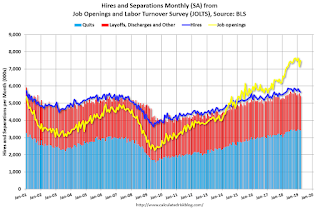Popular Economics Weekly
Real gross domestic product (GDP) increased at an annual rate of 3.1 percent in the first quarter of 2019, according to the Bureau of Economic Analysis. It was "second" estimate released by the Bureau of Economic Analysis. In the fourth quarter, real GDP increased 2.2 percent.
The growth is confounding some economists, as Q1 growth has been weak over past first quarters, per the BEA’s graph, while inflation is almost non-existent, with the core GDP price index up just 1.3 percent and declining.
But it’s not so confounding if we know it reflected an upturn in state and local government spending on infrastructure and other public services, since states are no longer waiting for the promised federal infrastructure bill that Trump is unable to come up with (hence the walkout of the scheduled meeting with Nancy Pelosi and Chuck Schumer that was to announce an infrastructure spending agreement).
Today's estimate reflects downward revisions to nonresidential fixed investment and private inventory investment and upward revisions to exports and personal consumption expenditures (PCE). Imports, continued the BEA report, which are a subtraction in the calculation of GDP, were revised up; the general picture of economic growth remains the same.
But the Q1 growth uptick from December may be an anomaly as corporate profits are also falling, which is limiting their investments in new plants and equipment. Adjusted corporate profits before taxes fell at an annual 2.8 percent pace, the biggest decline since 2015, according to MarketWatch.
Corporate profits have risen just 3.1 percent in the past 12 months, down from 10 percent less than a year earlier. That can explain why business investment rose just 2.3 percent in the first three months of the year, the revised GDP figures show.
Business investment is the seed corn for future growth, which means governments have to take up the slack if private business cuts back on basic spending that boosts productivity; or the US risks slumping back to 2 percent or less growth as happened prior to the Republicans’ December 2017 tax cuts that reduced corporate tax rates and gave a temporary boost to growth.
It’s therefore is a mystery why the Trump administration hasn’t made infrastructure a higher priority. It would create thousands of high-paying jobs.Congressional Republicans and Democrats have come together on a $2 trillion infrastructure bill, but can't get Trump's attention.
Most worrisome is the continued fall in interest rates, which has inverted the yield curve between 3-month and 10-year bond yields once again. The 10-year bond has fallen to 2.15 percent at this writing, the lowest in 5 years. Investors are fleeing to longer-term bonds because they fear an imminent slowdown.
Who can blame them with the China trade war taking on more ominous tones? China is now threatening to restrict the export of strategic rare earth minerals used in some of our most sensitive technology in response to the US banning of Huawei technologies in developing the US 5G Internet of the future.
One time frame given for a recession if the yield curve remains inverted for a prolonged period is 18 months—which would put it in the middle of next year’s Presidential campaign. But there’s also the possibility that the Federal Reserve will begin to lower interest rates to right the yield curve if they see a looming recession.
University of California economics Professor Peter Rupert summarized the odds of a looming recession in a recent forecast. Are there signs of a slowdown soon? “There are always some signs of slowing,” he said. Is there a recession coming? “There are always signs of a coming recession.” But when? “No one knows, sorry!”
Harlan Green © 2019
Follow Harlan Green on Twitter: https://twitter.com/HarlanGreen













